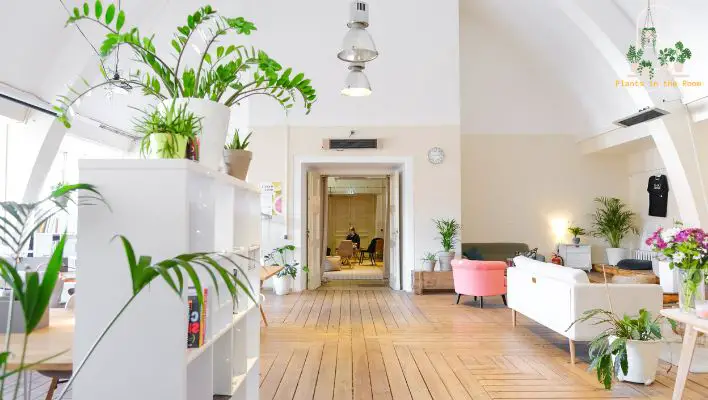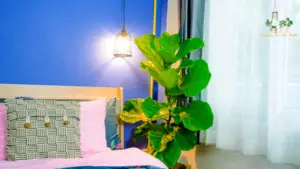This article covers the following areas –
- 1. Choosing the Right Plants
- 2. Match Plants with Your Lifestyle
- 3. Arranging Plants in Your Living Room
- 4. Caring for Your Plants
- In Conclusion
Plants can transform any room into a beautiful, lively, and fresh environment. Specifically, adding plants to your living room enhances its aesthetics, improves air quality, and creates a calming atmosphere. I’m here to help you understand how to incorporate plants into your living room, from choosing the right species to learning the best placement and care practices.
Decorating your living room with plants involves understanding the room’s light, temperature, and humidity conditions and selecting appropriate plants accordingly. Consider plant size, care needs, and use of vertical space to create a visually pleasing arrangement.
However, there is much more to learn to make the most of your indoor gardening journey. I encourage you to keep reading for more detailed information on choosing the right plants, creating a balanced arrangement, and ensuring your plants thrive in your living room environment.
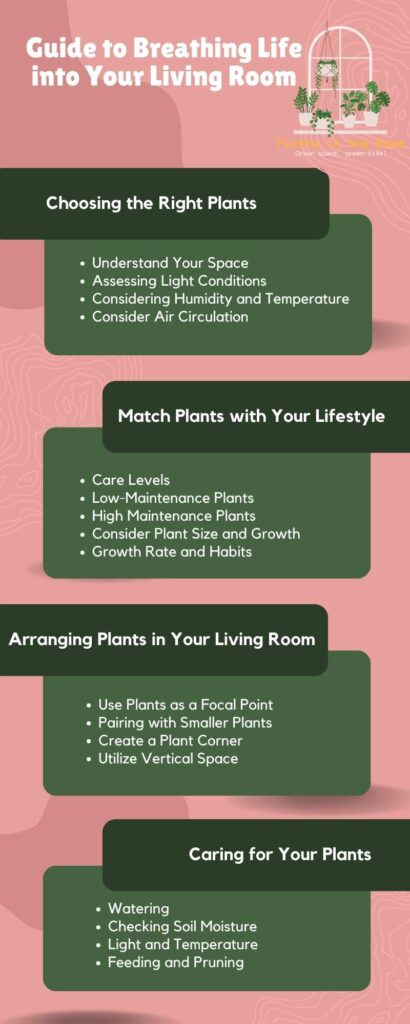
1. Choosing the Right Plants

Selecting the perfect plant for your living room can be an exciting journey. The right plants can act as living pieces of art that add a touch of nature and freshness to your space. It is important to consider the specific needs of each plant and match it with the conditions of your living room.
Moreover, the chosen plant should align with your lifestyle and the amount of time you can dedicate to its care. This section provides an in-depth guide on how to choose the perfect plants for your living room.
1.1 Understand Your Space
The first step in your journey to create a thriving indoor garden in your living room is to understand your space. This involves assessing your living room’s light conditions, temperature, and humidity levels.
These environmental conditions play a significant role in a plant’s health and will guide you in choosing the right plants. This section will help you understand how to evaluate your living room’s conditions and select plants that are likely to thrive in your specific environment.
1.1.1 Assessing Light Conditions
Natural light is a critical factor in a plant’s life, influencing its growth, photosynthesis, and flowering. The amount and intensity of natural light your living room receives determine what plants you can grow successfully.
- Bright Light Environments: If your living room is bathed in sunlight for most of the day, it is considered a bright light environment. Sun-loving plants like succulents or cacti are great choices for such settings. They thrive in lots of sunlight and can handle direct exposure to the sun’s rays.
- Low Light Environments: On the other hand, if your room only gets a small amount of indirect light, it is considered a low-light environment. But don’t worry; several plants thrive in such conditions. Shade-loving plants like snake plants or pothos are perfect candidates as they can survive and even thrive in less sunny conditions. These plants are used to growing under larger plants in their natural environments and have adapted to less light.
Remember, ‘low light’ does not mean ‘no light’. All plants need some light to survive.
1.1.2 Considering Humidity and Temperature
Just like outdoor plants, indoor plants also require specific temperature and humidity levels to thrive. The average temperature and humidity of your living room can affect a plant’s well-being significantly.
- High Humidity Plants: Some plants are native to tropical climates and love moisture in the air. Consider plants like ferns or palms if your living room tends to be humid. They will appreciate regular misting to simulate a tropical environment.
- Dry Environment Plants: Other plants are native to arid climates and prefer drier conditions. Snake plants or spider plants could be a good fit for drier environments. These plants are quite drought-tolerant and do not require high humidity to thrive.
1.1.3 Consider Air Circulation
Good air circulation is another factor to consider when understanding your space. Plants require fresh air to grow well. Stale, stagnant air can lead to the growth of fungi and disease. Ensure that your living room has good air circulation, but avoid placing your plants in the direct path of strong drafts.
By understanding the conditions of your living room, you can make informed decisions about which plants to bring into your home. This will increase the chances of your plants thriving, adding beauty and life to your living space.
2. Match Plants with Your Lifestyle
One of the joys of adding greenery to your home is the personal relationship you develop with your plants. However, it’s essential to remember that plants are living things that need care and attention. Like pets, different plants have different care needs.
Therefore, matching the plants you choose with your lifestyle and the amount of time you can dedicate to their care is paramount. This section will guide you through selecting plants that fit your lifestyle, whether you’re a busy bee or a passionate plant parent.
2.1 Care Levels
To match plants with your lifestyle, understanding the care levels of different plants is essential. Some plants require a lot of attention, while others are more independent.
2.1.1 Low-Maintenance Plants
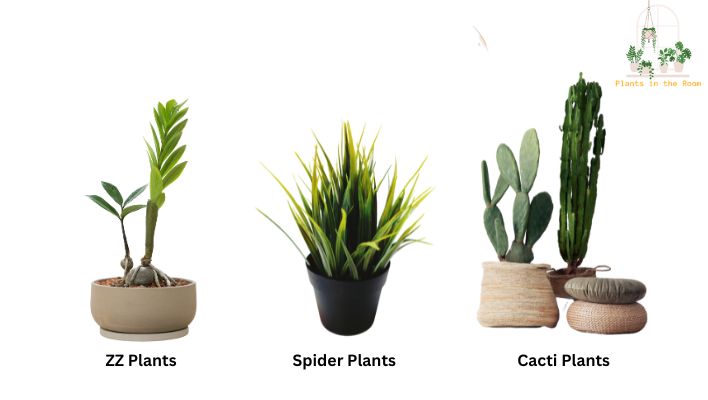
Low-maintenance plants are a great choice if you lead a busy lifestyle and have limited time to take care of plants. These plants can tolerate a bit of neglect, thrive even if watered infrequently, and generally require less care. Here are some examples of low-maintenance plants.
- ZZ Plants: These plants are known for their ability to survive in harsh conditions. They can tolerate low light and irregular watering. Their glossy, green leaves can add a fresh touch to your living room.
- Spider Plants: Spider plants are another excellent choice for a busy lifestyle. They can grow in a variety of conditions and aren’t easily affected by over or under-watering.
- Cacti: Cacti are desert plants that are adapted to survive with little water. They are great for a sunny spot in your living room and need minimal care.
2.1.2 High Maintenance Plants
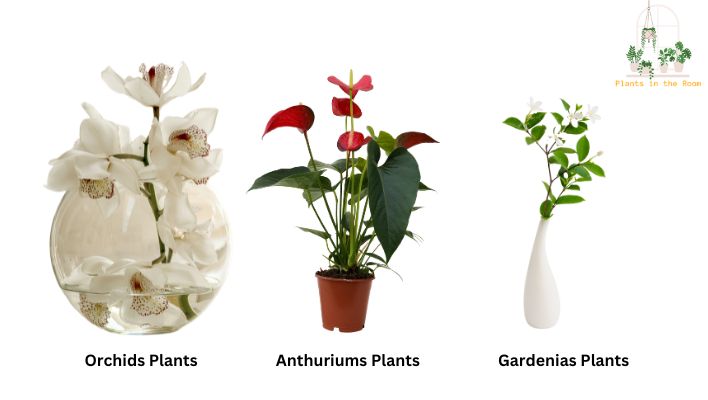
If you enjoy the process of caring for plants and have the time to dedicate, you’ll find high-maintenance plants rewarding to grow. These plants often flower, adding beautiful colors and often pleasant fragrances to your living room. Here are some examples of high-maintenance plants:
- Orchids: Orchids are exotic and beautiful but require specific care. They need the right balance of light, water, and humidity to thrive.
- Anthuriums: Known for their bright, heart-shaped flowers, Anthuriums need a warm, humid environment, bright, indirect light, and regular watering.
- Gardenias: Gardenias are admired for their fragrant, white flowers. However, they require a lot of attention, including regular watering, feeding, and specific light and humidity conditions.
Choosing the right plants to match your lifestyle will help ensure that your green companions thrive while also keeping your plant care routine manageable and enjoyable.
2.2 Consider Plant Size and Growth
Choosing the right plants for your living room isn’t just about picking those that catch your eye or match your decor. An often overlooked factor is the size of the plant and its potential growth. Similar to pets, some plants stay small and compact, while others grow big and spread wide.
Therefore, it’s essential to consider the space you have available in your living room and the plant’s growth habits before making a selection.
2.2.1 Understanding Plant Sizes
Plant sizes can vary widely, from tiny desktop succulents to towering indoor trees. It’s crucial to consider the plant’s mature size, not just its size at the time of purchase. Nurseries often sell young plants that can grow significantly after you bring them home. Here are some considerations depending on your space.
- Small Spaces: Choosing compact plants is wise if you have a small living room or limited space. Small succulents or air plants are perfect choices as they stay relatively small and don’t take up much space. Other small plants that could work well include spider plants or peace lilies. These plants remain manageable in size and are relatively easy to care for.
- Large Spaces: If you are lucky enough to have a spacious living room, consider making a striking statement with larger plants. Monstera deliciosa, known for its large, distinctive leaves, can be a stunning addition. Fiddle leaf figs, with their lush, sculptural foliage, can also add a dramatic touch.
2.2.2 Growth Rate and Habits
Apart from size, it’s also important to consider a plant’s growth rate and habits. Some plants grow quickly and might require regular pruning to keep them in check. Others grow slowly and remain the same size for a long period.
Plants also have different growth habits – some grow upright, others trail down, and some spread out. Choose plants with growth habits that suit your living room layout and your preferences.
Understanding a plant’s size and growth habits can help you choose plants that fit comfortably in your space and grow in a way that complements your living room. Remember, choosing the right plants for your living room requires consideration and care, but the resulting green haven will be worth the effort. Happy plant hunting!
3. Arranging Plants in Your Living Room
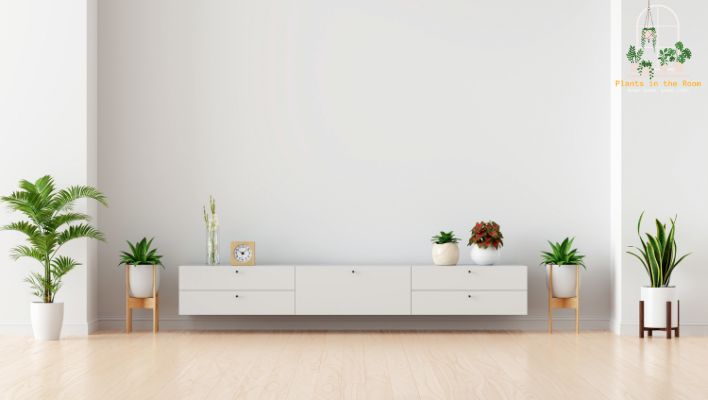
Once you have selected the perfect plants, the next step is to figure out how to arrange them in your living room. This step is much like arranging furniture but with living, breathing pieces. Well-placed plants can enhance the aesthetics of your room, create a calming atmosphere, and even become a conversation starter.
You can employ several strategies, from using plants as focal points to creating a plant corner or utilizing vertical spaces. This section will guide you through these strategies, helping you create an inviting and vibrant living room.
3.1 Use Plants as a Focal Point
The living room, often considered the heart of the home, is where we spend a significant amount of our time. It’s a place where we entertain guests, relax with family, or simply enjoy some quiet time. This central space deserves an attention-grabbing centerpiece that breathes life into the room. An excellent way to create this focal point is by using large, striking plants.
This section will guide you through choosing the right plants and effectively using them to draw attention and establish a natural centerpiece in your living room.
3.1.1 Choosing the Right Plant for Focal Point
Choosing the right plant is the key to using plants as a focal point. You need a large plant to draw attention and be visually interesting to keep.
- Fiddle-Leaf Figs: Known for their large, glossy, violin-shaped leaves, fiddle-leaf figs can grow to a considerable size and make a bold statement in your living room. They add an elegant, tropical touch to your space. However, they require good light and consistent care to thrive.
- Monstera Deliciosa: Often just called monstera or the Swiss cheese plant, this plant is another excellent choice for a focal point. It’s beloved for its large, unique leaves with natural holes, resembling Swiss cheese. Monstera can grow quite large and brings a dramatic tropical vibe to any room.
When choosing a plant to use as a focal point, ensure it has enough space to grow and that its location doesn’t obstruct walkways or views. Remember, these plants can grow quite large, so giving them the space they need is important.
3.1.2 Pairing with Smaller Plants
While a large, striking plant can act as a great focal point, it shouldn’t be alone. Pairing these large plants with smaller ones can create a visually balanced look. It also helps to emulate the plant’s natural environment, where different plant sizes and types coexist.
For instance, you could place a large monstera in a corner of your living room and surround it with smaller plants like ferns or snake plants. The smaller plants can fill the undergrowth, creating an appealing visual contrast and depth. This setup creates a dynamic visual interest and leads the eye around the space, enhancing the overall aesthetic of your living room.
Using plants as a focal point in your living room is a creative way to draw attention and bring a sense of life and nature into your home. With the right choice and arrangement of plants, your living room can become a captivating indoor oasis.
3.2 Create a Plant Corner

One creative way to liven up your living room is by designating a special corner for your plants. A plant corner is a dedicated space where you can create your own indoor garden. This mini garden brings a fresh, vibrant feel to the room and serves as an impressive showcase for your plants.
It’s an excellent strategy if you have a variety of plants or if you want to create a specific mood in your living room. This section will guide you through the process of setting up your plant corner and arranging the plants effectively.
3.2.1 Grouping Plants Together
A plant corner comes to life when different types of plants are grouped together. This grouping should create an aesthetic balance while highlighting each plant’s unique beauty. Mix plants of different heights, shapes, and colors to add visual interest and create a sense of natural diversity. Here is a potential arrangement for your plant corner:
- Base Layer: Start with larger, floor-standing plants like a rubber plant or a yucca. These plants act as the foundation of your plant corner. Their height and size make them noticeable and allow them to anchor the whole setup.
- Middle Layer: Add medium-sized plants such as pothos or peace lilies on top of the base layer. You can place these plants on small stands or decorative stools to elevate them off the ground and create visual layers.
- Top Layer: Finish with smaller plants or trailing plants, like a string of pearls or ivy, on higher shelves or hanging baskets. These plants draw the eye upward and complete the vertical interest of your plant corner.
3.2.2 Creating an Indoor Garden Vibe
Creating an indoor garden vibe in your plant corner involves more than just arranging plants. It’s about incorporating different elements that give the space an authentic, garden-like feel. For example, you can add moss, decorative rocks, or small figurines among the plants to emulate a natural landscape.
- Moss: Moss adds a touch of softness and greenery to your plant corner. You can add moss to the topsoil of your potted plants for added texture and a more garden-like feel.
- Decorative Rocks: These can be used to decorate the topsoil or as a decorative element in clear glass pots. They provide a nice contrast to the lush greenery of the plants and bring a sense of nature indoors.
- Figurines: Small garden figurines or garden gnomes can add a whimsical touch to your plant corner, enhancing the garden vibe.
Creating a plant corner in your living room can transform the space into a serene, green haven. It offers a chance to express your creativity, curate a beautiful collection of plants, and bring a slice of nature into your home. So start planning your plant corner and enjoy the process of bringing it to life!
3.3 Utilize Vertical Space
While the floor and furniture surfaces offer great space to display your plants, they aren’t the only options. Making use of your living room’s vertical space can open up a whole new world of plant display possibilities. This strategy is particularly useful if your living room is small or you have a large plant collection running out of surface space.
Vertical plant arrangements can also add a unique visual interest, drawing the eye upward and creating a sense of height and depth. Let’s dive into some of the ways you can utilize vertical space for your plants.
3.3.1 Hanging Plants
Hanging plants can be a beautiful addition to your living room, adding a touch of nature at eye level or above. They can be hung from the ceiling, curtain rods, or even wall hooks.
Plants with trailing vines are perfect for hanging baskets. For instance:
- The String of Pearls: This succulent plant has a unique look with its small, round ‘pearls’ that trail down. It’s a hardy plant that doesn’t require much water, making it a good choice for a hanging plant.
- English Ivy: This classic trailing plant can quickly grow long, lush vines. It can add a dramatic touch to your living room when hung high.
- Spider Plant: With their arching leaves and baby plantlets, spider plants are attractive and easy-to-care-for hanging plants.
Remember to place your hanging plants in locations that meet their light requirements.
3.3.2 Wall-Mounted Planters and Tall Plant Stands
Wall-mounted planters and tall plant stand to offer more ways to display your plants vertically. These options save floor space and add a unique visual element to your living room.
- Wall-Mounted Planters: These planters can hold small to medium-sized plants and be arranged in various ways on your walls. Succulents, ferns, or pothos could be great choices for these planters.
- Tall Plant Stands: Plant stands come in various heights, allowing you to create a tiered plant display. They can hold larger plants and raise them to different eye levels. Snake plants or peace lilies could look fantastic on these stands.
Arranging plants in your living room’s vertical space enhances your room’s aesthetics and allows you to have more plants in a limited space. It’s a creative process that involves some experimentation to find what works best for your space and your plants.
But once you’ve achieved the right arrangement, your living room will feel more vibrant and energetic – more like a living ecosystem. Enjoy the process of decorating and bringing your space to life with plants!
4. Caring for Your Plants
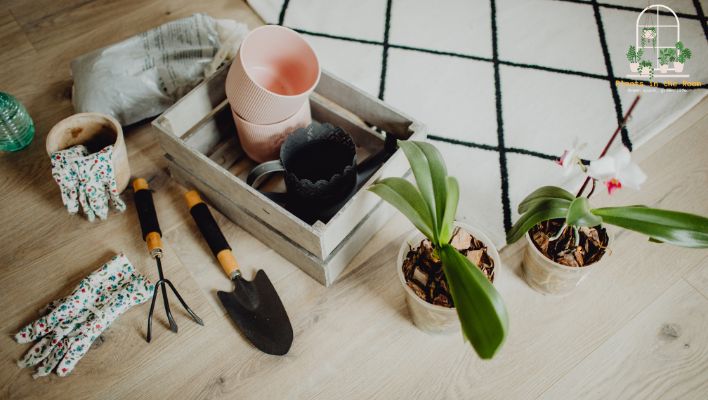
After selecting and arranging your plants, it becomes crucial to ensure they thrive. Just like humans, plants require the right amount of water, light, and warmth to stay healthy.
Additionally, they may need occasional feeding and pruning. It might seem like a lot to handle, especially if you’re new to gardening, but don’t worry. This section provides an easy-to-follow guide on caring for your new green companions.
4.1 Watering
Proper watering is a fundamental part of plant care, though it often seems to be a source of confusion for many. Watering might sound like a simple task—just add water, right? But, too much enthusiasm can lead to overwatering, a common mistake that can harm or even kill your plants.
Conversely, too little water can also have damaging effects. In this section, we’ll explore how to navigate these tricky waters and ensure your plants stay hydrated just right.
4.1.1 Determining Water Requirements
Just like humans, different plants have different water requirements. Understanding what each plant needs can go a long way in maintaining its health and vitality. Generally, plants can be categorized into those that love consistently moist soil and those that prefer their soil to dry out completely between waterings.
- Moisture-loving plants: Plants like peace lilies and ferns love consistently moist soil. This doesn’t mean they need to be watered all the time, but the soil should not be allowed to dry out completely.
- Drought-tolerant plants: Succulents and snake plants, on the other hand, prefer their soil to dry out completely between waterings. Overwatering can lead to root rot in these plants.
Always research the specific watering needs of each plant you bring into your home to avoid overwatering or underwatering.
4.1.2 Checking Soil Moisture
A good general rule of thumb when it comes to watering most plants is to wait until the top inch of the soil is dry before watering again. You can check this by sticking your finger into the soil, about up to your first knuckle. If the soil feels dry at that depth, it’s time to water.
4.1.3 Factors Affecting Watering Frequency
Watering is not a one-size-fits-all task. Several factors can affect how often a plant needs to be watered.
- Pot Size: Plants in smaller pots will typically need to be watered more frequently than those in larger pots because the soil will dry out more quickly.
- Environmental Conditions: Plants in warmer, drier environments will also require more frequent watering. On the other hand, during colder months or in more humid conditions, you can scale back on watering.
Remember, the goal is to mimic each plant’s natural environment as closely as possible. When in doubt, it’s generally better to err on the side of underwatering. Plants can often recover from a bit of drought, but they might not be so forgiving if they’re overwatered. Happy watering!
4.2 Light and Temperature
Just as the right diet is important for our health, the correct amount of light and temperature is crucial for your plants’ well-being. Each plant has its own preferred lighting and temperature conditions, and creating an environment that closely matches its natural habitat can significantly contribute to its health and growth.
4.2.1 Providing the Right Amount of Light
Like people, plants have their own light preferences. Some love basking in bright, direct sunlight, while others prefer the cool shade or indirect light. Providing your plants with the type of light they love can help them thrive and grow.
- Sun-loving plants: Plants like succulents and cacti soak up sunlight like a sponge. They love basking in bright, direct sunlight and can often handle the full midday sun.
- Shade-loving plants: On the other end of the spectrum, some plants have adapted to grow under the canopy of larger plants in their natural habitats. Snake plants and pothos are two examples of houseplants that do well in low-light conditions.
Make sure to position your plants in your living room according to their light preferences. Check each plant’s light requirements when you bring it home and find a spot in your living room that matches those conditions.
4.2.2 Maintaining Appropriate Temperature
Along with light, temperature is another vital factor for plant growth and survival. Most common houseplants prefer temperatures between 60-75°F (15-24°C) during the day and a drop by about 10°F (5°C) at night. This replicates the typical day and night temperature variations in their natural environments.
However, be mindful of plants near windows, especially during winter or summer. During winter, cold drafts can damage tropical plants, while during summer, the area near a window can become significantly hotter than the rest of the room.
Additionally, sudden changes in temperature can stress plants. Try to keep the temperature as stable as possible, avoiding placing plants near heating or cooling vents.
Understanding and catering to your plants’ light and temperature needs may seem like a science, but with careful observation and a little research, you’ll soon become fluent in the language of plants. Happy growing!
4.3 Feeding and Pruning
Just as humans need nutrition and grooming to be healthy, plants also require feeding and pruning to maintain their well-being. This final part of our guide will help you understand the importance of feeding your plants with the right nutrients and the art of pruning to keep them healthy and visually appealing.
4.3.1 Feeding Your Plants
While water and sunlight are crucial for plant survival, they also need various nutrients to thrive. These nutrients are typically absorbed from the soil in their natural habitats. For houseplants, these nutrients need to be provided through fertilizers.
Feed your plants using a balanced, water-soluble fertilizer that includes a mix of primary nutrients (nitrogen, phosphorous, and potassium) and secondary nutrients (calcium, magnesium, and sulfur).
Check the label on your fertilizer for specific instructions on how much to use and how often to apply it. Typically, houseplants benefit from feeding once a month, but this can vary based on the type of plant and its growth phase.
Remember, over-fertilizing can harm your plants, causing leaf burn or even death. So, it’s crucial to follow the recommended amounts.
4.3.2 Pruning Your Plants
Pruning is an essential part of plant care that helps maintain a plant’s shape, encourages growth, and keeps the plant healthy. Regular pruning involves removing dead or yellowing leaves, which allows the plant to focus its energy on new growth.
Always use clean, sharp scissors or pruning shears to make clean cuts when pruning. This helps prevent the spread of diseases. In general, it’s best to prune in early spring before the plant’s growing season begins, but always check the specific requirements for each plant.
Feeding and pruning might seem like advanced gardening tasks, but with a bit of practice, they’ll become second nature. By giving your plants the nutrients they crave and the grooming they need, you can ensure they’ll continue to breathe life into your living room.
Keep in mind that each plant is a unique individual with its own preferences and needs. Take the time to learn about the specific care requirements for each of your plants, and you’ll be rewarded with a thriving indoor garden. Happy gardening!
In Conclusion
Inviting plants into your living room can make it feel more vibrant, warm, and inviting. Your living room can truly come to life with careful selection, thoughtful placement, and proper care. Remember, nurturing plants takes time and patience, but the rewards are well worth the effort.

